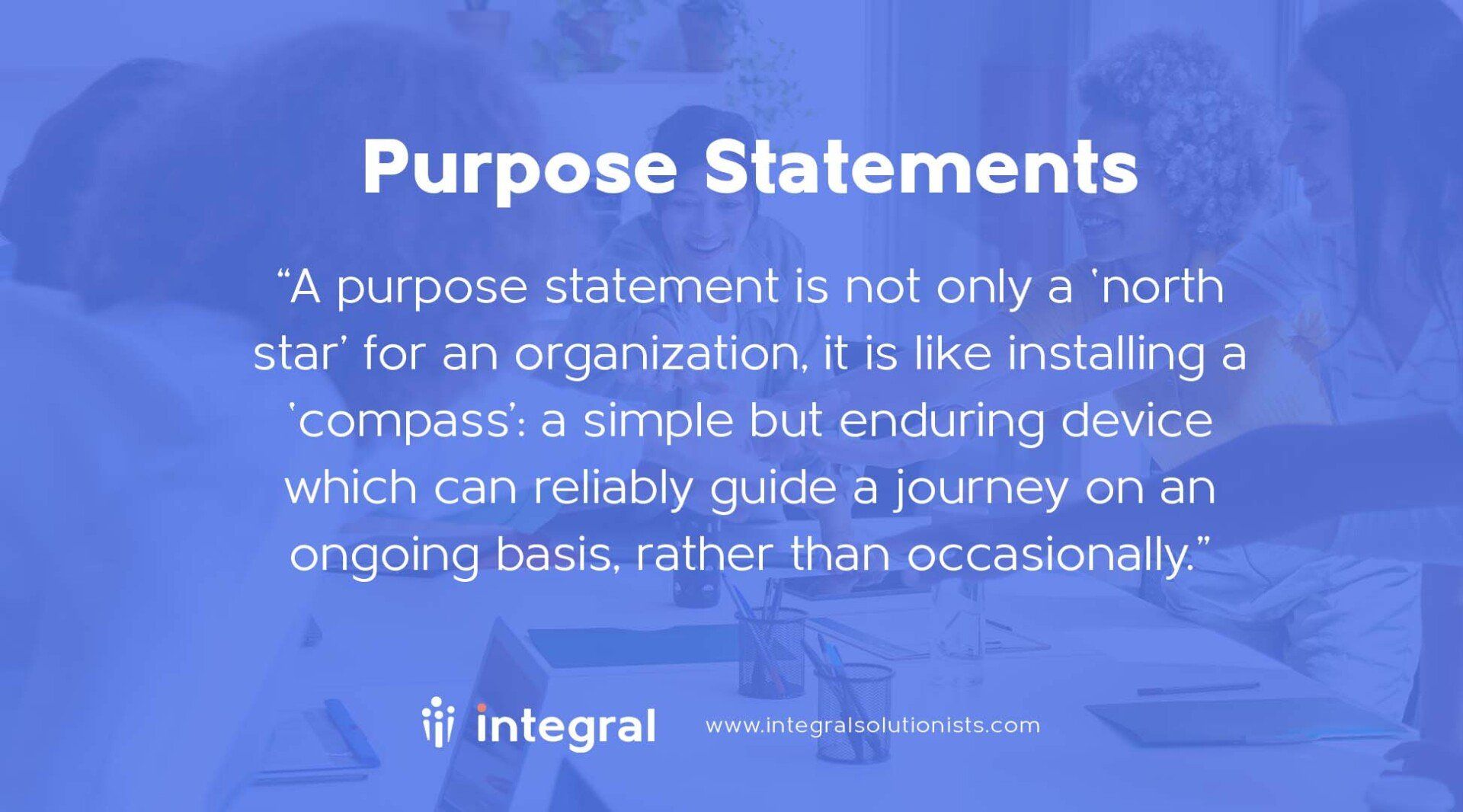What are Corporate Purpose Statements? And Why Your Company Should Have One.
Stay up-to-date on trends shaping the future of governance.
Corporate mission statements have been around for a long time. Management guru Peter Drucker was an early advocate for every organization to have one, in order to anchor its reason for existence by having a clear answer to the question: What is our mission? Indeed, that question headed Drucker’s list of ‘The Five Most Important Questions which You Can Ask your Organization”, the title of his widely quoted book published in 1973. That book proved so influential that, more than forty years later, an edited sequel subtitled ‘Enduring Wisdom for Today’s Leaders’ brought together a set of responses to each of Drucker’s questions from contemporary researchers and leaders. In his commentary on the importance of the first question, Jim Collins, who is himself the acclaimed author of books like Good to Great, states that “mission as Drucker thought of it provides the glue that holds an organization together as it expands, decentralizes, globalizes, and attains diversity.”
The emphasis of mission statements has evolved over time. A recent study (available
here) compared the wording of the mission statements of companies on the 2016 Fortune 100 list to those of 2001. The
most notable change over time was more frequent mentions of customers and especially of communities, a category which did not feature much at all in 2001. By contrast, explicit references to shareholders in the mission had declined. This is hardly surprising in an age in which the term ‘stakeholder capitalism’ has emerged to capture the
zeitgeist
that value creation for shareholders is no longer the exclusive or even primary aim of business. Linked to the rise of stakeholderism, there has been an emphasis on defining corporate
purpose statements,
rather than mission statements.
Mission statements have not yet been supplanted: according to Google Trends, the term ‘mission statement’ is still used more commonly by a factor of 10 than ‘purpose statement’, but the trend in its usage has been generally downward over the past seventeen years.
What’s the difference between mission statements and purpose statements?
If mission statements are about the reason for an organization’s existence, how are purpose statements different, if at all? Some commentators point to a difference in focus: mission statements are meant to define ‘what’ an organization does while purpose statements answer ‘why’ it does it. Some distinguish the time frames–a mission statement is what a company does now while purpose is an expression of what it wants to do in future. But others may quibble at that distinction, instead calling the future-oriented statement a vision statement. Vision statements are commonly found in the trifecta with mission statements and values statements. Some commentators emphasize the distinctiveness of purpose statements in that they should define more clearly who benefits from the activities of an organization, that is, for whom it creates value; and how it does so, linked to some identified distinctive ‘superpower’. But that description still sounds pretty close to the way many mission statements are structured.
My own view is that the
purpose statement is mainly a ‘facelift’ of the mission statement, which doesn’t change the substance much. However, using the updated language of purpose probably reflects the fact that mission statements have often been ignored or even discredited in the practices of many organizations whose stakeholders would not be able to cite what the mission is. Restating purpose now is a way of recognizing and even re-calibrating the balance among stakeholder groups in ways which should support sustainability. Certainly, the understanding and achievement of purpose is at the center of the new
ISO 37000
framework on governance on which I have written before
here. The relevant question is therefore less about how the two terms are different but rather whether
purpose statements can do any better at the task of providing foundational alignment than mission statements
have done in the past.
Learn how to define your company's purpose with the FREE Corporate Purpose Guide.
Sent straight to your inbox as a PDF document.
What makes a good purpose statement?
There are two factors which may enable purpose statements to fulfill their purpose as organizational focusing devices, if not forcing devices. The first is a general trend: the rising demands for greater accountability by public companies for their societal impact means that a purpose statement is more likely to be taken seriously by civil society groups and activist shareholders than mission statements were fifty years ago.
Secondly, the
clarity and resonance of the statements
themselves can make them more effective. Management journals are full of advice about what makes for a good purpose statement. For example, a
2020 Forbes article
by Afdhel Aziz on the ‘power of purpose’ lists a number of attributes of good statements with accompanying examples. Good statements should be both short and sweet, empowering and personal. In this respect, Lego’s crisp and clear statement “To inspire and develop the builders of tomorrow” is often favorably cited. It can also be helpful to demonstrate an emotional connection, as in the example of Whole Foods: “Our deepest purpose as an organization is helping support the health, well-being, and healing of both people—customers, Team Members, and business organizations in general—and the planet.” Embedding a tension in the statement–between quality and wider access–may help energize a company to deliver on a challenging mission. The example cited for this is Chobani’s: “To make
better
food for
more
people.”

However, the way in which purpose is framed is not uncontroversial. Take Starbucks’ current statement: “to inspire and nurture the human spirit – one person, one cup and one neighborhood at a time.” Now that sounds short and sweet to me, with a ‘spoonful’ of emotional resonance stirred in! But the
Strategic Management Insight blog
gives this its lowest score among the statements evaluated for not being clear or comprehensive enough, and specifically for not covering the 9 categories of issues, such as clarity of stakeholders, which its authors believe are needed in a purpose statement.
Process speaks purpose
The wording of purpose statements clearly matters but it may matter less than the process by which a statement is developed, or redeveloped. Ultimately, a good purpose statement can be recognized by its effect on those who matter to the organization. One desired outcome is
awareness and identification: the extent to which all key stakeholders–staff, customers, suppliers and yes, shareholders–are aware of the purpose; and the extent to which they identify or align with it. In this sense, the purpose statement is the ‘DNA’ of organizational brand identity–clarifying what the organization stands for, works for, even fights for. Another desired outcome is
relevance: the degree to which the statement actually guides organizational decision-making. If management, board or employees seldom if ever make reference to purpose in the context of decisions to be made, that is a sure sign that the
statement is more wallpaper than cornerstone. But making a purpose statement relevant involves an ongoing process to create traction.

A purpose statement is not only a ‘north star’ for an organization: that is, a distant point of occasional orientation which is not visible to the eye for much of the day. It is also about the journey. In this sense, clarifying the purpose can be like installing a ‘compass’: a simple but enduring device which can reliably guide a journey on an ongoing basis, rather than occasionally.
Just as famously ‘culture eats strategy for breakfast’,
culture snacks on purpose. But instead of getting the occasional sugar hit, organizations can choose instead to make purpose the foundation of a nutritious culture–that is, one which energizes a resilient sustainable value-creating organization. This requires a conscious commitment to a comprehensive process of defining purpose initially, and then of reinforcing it in the life of the organization.
While the purpose statement may simply be a reincarnation of the mission statement in the Twenty-first century, the move to define purpose offers organizations an opportunity to navigate tensions and tradeoffs in the age of stakeholder capitalism. That may be their true value add; but to extract that value will require effort and focus.

Lead your company into a thriving future with the FREE Corporate Purpose Guide
Sent straight to your inbox as a PDF document.
At Integral, we provide ESG Consulting advice, evaluation, facilitation, mentoring and coaching services to develop governance systems that fit your organization’s purpose and stage of growth. To explore further how we can help you,
read about our services, or
set up a free consultation.
S H A R E











